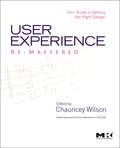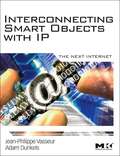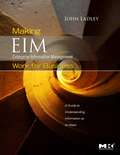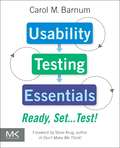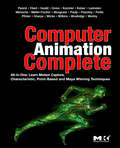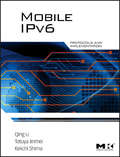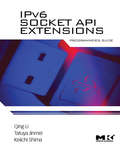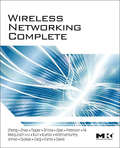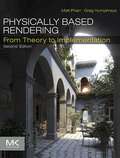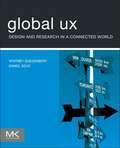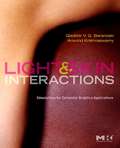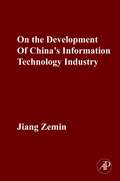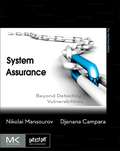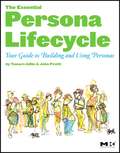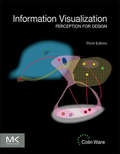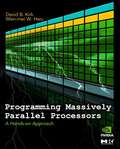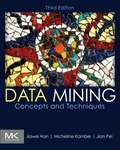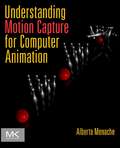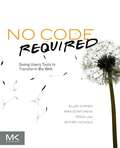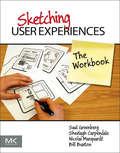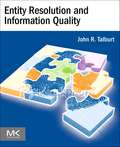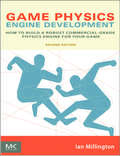- Table View
- List View
User Experience Re-Mastered: Your Guide to Getting the Right Design
by Chauncey WilsonUser Experience Re-Mastered: Your Guide to Getting the Right Design provides an understanding of key design and development processes aimed at enhancing the user experience of websites and web applications. The book is organized into four parts. Part 1 deals with the concept of usability, covering user needs analysis and card sorting—a tool for shaping information architecture in websites and software applications. Part 2 focuses on idea generation processes, including brainstorming; sketching; persona development; and the use of prototypes to validate and extract assumptions and requirements that exist among the product team. Part 3 presents core design principles and guidelines for website creation, along with tips and examples on how to apply these principles and guidelines. Part 4 on evaluation and analysis discusses the roles, procedures, and documents needed for an evaluation session; guidelines for planning and conducting a usability test; the analysis and interpretation of data from evaluation sessions; and user interface inspection using heuristic evaluation and other inspection methods.*A guided, hands-on tour through the process of creating the ultimate user experience – from testing, to prototyping, to design, to evaluation *Provides tried and tested material from best sellers in Morgan Kaufmann’s Series in Interactive Technologies, including leaders in the field such as Bill Buxton and Jakob Nielsen *Features never before seen material from Chauncey Wilson’s forthcoming, and highly anticipated Handbook for User Centered Design
Interconnecting Smart Objects with IP: The Next Internet
by Jean-Philippe Vasseur Adam DunkelsInterconnecting Smart Objects with IP: The Next Internet explains why the Internet Protocol (IP) has become the protocol of choice for smart object networks. IP has successfully demonstrated the ability to interconnect billions of digital systems on the global Internet and in private IP networks. Once smart objects can be easily interconnected, a whole new class of smart object systems can begin to evolve. The book discusses how IP-based smart object networks are being designed and deployed. The book is organized into three parts. Part 1 demonstrates why the IP architecture is well suited to smart object networks, in contrast to non-IP based sensor network or other proprietary systems that interconnect to IP networks (e.g. the public Internet of private IP networks) via hard-to-manage and expensive multi-protocol translation gateways that scale poorly. Part 2 examines protocols and algorithms, including smart objects and the low power link layers technologies used in these networks. Part 3 describes the following smart object network applications: smart grid, industrial automation, smart cities and urban networks, home automation, building automation, structural health monitoring, and container tracking.Shows in detail how connecting smart objects impacts our lives with practical implementation examples and case studies Provides an in depth understanding of the technological and architectural aspects underlying smart objects technology Offers an in-depth examination of relevant IP protocols to build large scale smart object networks in support of a myriad of new services
Making Enterprise Information Management (EIM) Work for Business: A Guide to Understanding Information as an Asset
by John LadleyMaking Enterprise Information Management (EIM) Work for Business: A Guide to Understanding Information as an Asset provides a comprehensive discussion of EIM. It endeavors to explain information asset management and place it into a pragmatic, focused, and relevant light. The book is organized into two parts. Part 1 provides the material required to sell, understand, and validate the EIM program. It explains concepts such as treating Information, Data, and Content as true assets; information management maturity; and how EIM affects organizations. It also reviews the basic process that builds and maintains an EIM program, including two case studies that provide a birds-eye view of the products of the EIM program. Part 2 deals with the methods and artifacts necessary to maintain EIM and have the business manage information. Along with overviews of Information Asset concepts and the EIM process, it discusses how to initiate an EIM program and the necessary building blocks to manage the changes to managed data and content.Organizes information modularly, so you can delve directly into the topics that you need to understandBased in reality with practical case studies and a focus on getting the job done, even when confronted with tight budgets, resistant stakeholders, and security and compliance issuesIncludes applicatory templates, examples, and advice for executing every step of an EIM program
Usability Testing Essentials: Ready, Set...Test!
by Carol M. BarnumUsability Testing Essentials provides readers with the tools and techniques needed to begin usability testing or to advance their knowledge in this area. The book begins by presenting the essentials of usability testing, which include focusing on the user and not the product; knowing when to conduct small or large studies; and thinking of usability as hill climbing. It then reviews testing options and places usability testing into the context of a user-centered design (UCD). It goes on to discuss the planning, preparation, and implementation of a usability test. The remaining chapters cover the analysis and reporting of usability test findings, and the unique aspects of international usability testing. This book will be useful to anyone else involved in the development or support of any type of product, such as software or web developers, engineers, interaction designers, information architects, technical communicators, visual or graphic designers, trainers, user-assistance specialists, and instructional technologists.Provides a comprehensive, step-by-step guide to usability testing, a crucial part of every product’s developmentThe fully updated four-color edition now features important usability issues such as international testing, persona creation, remote testing, and accessibilityFollow-up to Usability Testing and Research (9780205315192, Longman, 2001), winner of the highest-level award from the Society for Technical Communication
Computer Animation Complete: All-in-One: Learn Motion Capture, Characteristic, Point-Based, and Maya Winning Techniques
by David Gould Mark V. Pauly Matthias Müller Alberto Menache David S. Ebert Rick Parent Markus Gross Chris Kazmier Charles John Lumsden Richard Keiser F. Kenton Musgrave Darwyn Peachey Ken Perlin Hanspeter Pfister Jason Sharpe Mark R. Wilkins Martin Wicke Nicholas Woolridge Steve WorleyA compilation of key chapters from the top MK computer animation books available today - in the areas of motion capture, facial features, solid spaces, fluids, gases, biology, point-based graphics, and Maya. The chapters provide CG Animators with an excellent sampling of essential techniques that every 3D artist needs to create stunning and versatile images. Animators will be able to master myriad modeling, rendering, and texturing procedures with advice from MK's best and brightest authors. Divided into five parts (Introduction to Computer Animation and Technical Background, Motion Capture Techniques, Animating Substances, Alternate Methods, and Animating with MEL for MAYA), each one focusing on specific substances, tools, topics, and languages, this is a MUST-HAVE book for artists interested in proficiency with the top technology available today! Whether you're a programmer developing new animation functionality or an animator trying to get the most out of your current animation software, Computer Animation Complete: will help you work more efficiently and achieve better results. For programmers, this book provides a solid theoretical orientation and extensive practical instruction information you can put to work in any development or customization project. For animators, it provides crystal-clear guidance on determining which of your concepts can be realized using commercially available products, which demand custom programming, and what development strategies are likely to bring you the greatest success. Expert instruction from a variety of pace-setting computer graphics researchers.Provides in-depth coverage of established and emerging animation algorithms.For readers who lack a strong scientific background, introduces the necessary concepts from mathematics, biology, and physics.A variety of individual languages and substances are addressed, but addressed separately - enhancing your grasp of the field as a whole while providing you with the ability to identify and implement solutions by category.
Mobile IPv6: Protocols and Implementation
by Qing Li Tatuya Jinmei Keiichi ShimaMobile IPv6 has become the key enabling technology for mobile data and multimedia services and devices worldwide (i.e., cellular systems, VoIP handovers over LAN, multi-access network handovers, location privacy, enterprise mobile networking, etc.). This book covers the IPv6 host mobility protocol known as "mobile IPv6" and begins with a basic description of mobile IPv6 and then details protocol specifications and data structures as well as actual implementation. A sample configuration for a real Mobile IPv6 operation is provided at the end of the book.Provides a detailed introduction to the IETF Mobile IPv6 standardIncludes extensive line-by-line code sets with meticulous explanations of their implementationNumerous diagrams and illustrations to help in visualizing the implementation
IPv6 Socket API Extensions: Programmer's Guide
by Qing Li Jinmei Tatuya Keiichi ShimaIPv6 Socket API Extensions: Programmer's Guide covers the IPv6 application programming intercfaces (API) extensions and enhancements that have been made to the socket APIs. The book begins with a brief overview of the API specifications along with sample code usage. Then an explanation of the internal kernel implementation that realizes the services offered by the API sets is detailed. Also descriptions of several standard user libraries that have been extended or created to support IPV6 are reviewed. Includes various examples which illustrate how to write portable applications that can run on either IPv4 or IPv6 networks. Succinct treatment of everything you need know to get up and running with IPv6 socket programming in one affordable volume.Provides a detailed introduction to the IETF standards for IPv6 APIsIncludes extensive line-by-line code sets with meticulous explanations of their implementationNumerous diagrams and illustrations to aid in fully understanding the socket APIs
Wireless Networking Complete
by Larry L. Peterson Bruce S. Davie Adrian Farrel Pei ZhengWireless Networking Complete is a compilation of critical content from key Morgan Kaufmann titles published in recent years on wireless networking and communications. Individual chapters are organized into one complete reference giving a 360-degree view from our bestselling authors. From wireless application protocols, to Mesh Networks and Ad Hoc Sensor Networks, to security and survivability of wireless systems – all of the elements of wireless networking are united in a single volume. The book covers both methods of analysis and problem-solving techniques, enhancing the reader’s grasp of the material and ability to implement practical solutions. This book is essential for anyone interested in new and developing aspects of wireless network technology. Chapters contributed by recognized experts in the field cover theory and practice of wireless network technology, allowing the reader to develop a new level of knowledge and technical expertise Up-to-date coverage of wireless networking issues facilitates learning and lets the reader remain current and fully informed from multiple viewpointsPresents methods of analysis and problem-solving techniques, enhancing the reader’s grasp of the material and ability to implement practical solutions
Physically Based Rendering: From Theory to Implementation
by Matt Pharr Greg HumphreysPhysically Based Rendering, Second Edition, describes both the mathematical theory behind a modern photorealistic rendering system as well as its practical implementation. A method known as literate programming combines human-readable documentation and source code into a single reference that is specifically designed to aid comprehension. The result is a stunning achievement in graphics education. Through the ideas and software in this book, you will learn to design and employ a full-featured rendering system for creating stunning imagery. This new edition greatly refines its best-selling predecessor by streamlining all obsolete code as well as adding sections on parallel rendering and system design; animating transformations; multispectral rendering; realistic lens systems; blue noise and adaptive sampling patterns and reconstruction; measured BRDFs; and instant global illumination, as well as subsurface and multiple-scattering integrators. These updates reflect the current state-of-the-art technology, and along with the lucid pairing of text and code, ensure the book's leading position as a reference text for those working with images, whether it is for film, video, photography, digital design, visualization, or gaming.The book that won its authors a 2014 Academy Award for Scientific and Technical Achievement from the Academy of Motion Picture Arts and SciencesNew sections on subsurface scattering, Metropolis light transport, precomputed light transport, multispectral rendering, and much moreIncludes a companion site complete with source code for the rendering system described in the book, with support for Windows, OS X, and Linux: visit www.pbrt.orgCode and text are tightly woven together through a unique indexing feature that lists each function, variable, and method on the page that they are first described
Global UX: Design and Research in a Connected World
by Whitney Quesenbery Daniel SzucGlobal UX: Design and Research in a Connected World discusses how user experience (UX) practice is changing and how practitioners and teams around the world are creating great user experiences for a global context. The book is based on interviews with practitioners from many countries, working on different types of projects. It looks behind the scenes at what it takes to create a user experience that can work across borders, cultures, and languages. The book begins with a quick look at the world outside of UX. This includes the external forces of change and globalization as well as an overview of how culture affects designers and the UX of products. It considers what global UX means for an individual practitioner, a company, and teams. It then turns to the details of global UX with the process and practice of research in the field; how information is brought home and shared with colleagues; and how it is applied in design. The final chapter presents some thoughts about how to deliver value both to projects and the users of finished products.Covers practical user experience best practices for the global environmentFeatures numerous, global, real-world examples, based on interviews with over 60 UX managers and practitioners from around the worldContains case studies and vignettes from user research and design projects for multinational companies and small start-ups
Thoughts on Interaction Design
by Jon KolkoThoughts on Interaction Design explores the theory behind the field of Interaction Design in a new way. It aims to provide a better definition of Interaction Design that encompasses the intellectual facets of the field and the particular methods used by practitioners in their day-to-day experiences. It also attempts to provide Interaction Designers with the vocabulary necessary to justify their existence to other team members. The book positions Interaction Design in a way that emphasizes the intellectual facets of the discipline. It discusses the role of language, argument, and rhetoric in the design of products, services, and systems. It examines various academic approaches to thinking about Design, and concludes that the Designer is a liberal artist left to infuse empathy in technologically driven products. The book also examines the tools and techniques used by practitioners. These include methods for structuring large quantities of data, ways of thinking about users, and approaches for thinking about human behavior as it unfolds over time. Finally, it introduces the idea of Interaction Design as an integral facet of the business development process.*First book to provide a solid definition and framework for the booming field of interaction design, finally giving designers the justification needed to prove their essential role on every development team *Provides designers with tools they need to operate effectively in the workplace without compromising their goals: making useable, useful, and desirable products *Outlines process, theory, practice, and challenges of interaction design – intertwined with real world stories from a variety of perspectives
Light and Skin Interactions: Simulations for Computer Graphics Applications
by Aravind Krishnaswamy Gladimir V. BaranoskiLight and Skin Interactions immerses you in one of the most fascinating application areas of computer graphics: appearance simulation. The book first illuminates the fundamental biophysical processes that affect skin appearance, and reviews seminal related works aimed at applications in life and health sciences. It then examines four exemplary modeling approaches as well as definitive algorithms that can be used to generate realistic images depicting skin appearance. Despite its wide scope of simulation approaches, the book’s content is presented in a concise manner, focusing on relevant practical aspects. What’s more, these approaches can be successfully applied to a wide range of additional materials, such as eye tissue, hair, and water.Allows you to understand and predict the qualitative and quantitative behavior of complex natural systemsA general background on tissue optics clarifies several confusing conceptual issues, saving you valuable time in the early stages of researchIncludes complete code and data sources for the BioSpec model
Thoughts on Interaction Design
by Jon KolkoThoughts on Interaction Design, Second Edition, contemplates and contributes to the theory of Interaction Design by exploring the semantic connections that live between technology and form that are brought to life when someone uses a product. It defines Interaction Design in a way that emphasizes the intellectual and cultural facets of the discipline. This edition explores how changes in the economic climate, increased connectivity, and international adoption of technology affect designing for behavior and the nature of design itself. Ultimately, the text exists to provide a definition that encompasses the intellectual facets of the field, the conceptual underpinnings of interaction design as a legitimate human-centered field, and the particular methods used by practitioners in their day-to-day experiences. This text is recommended for practicing designers: interaction designers, industrial designers, UX practitioners, graphic designers, interface designers, and managers.Provides new and fresh insights on designing for behavior in a world of increased connectivity and mobility and how design education has evolved over the decadesMaintains the informal-yet-informative voice that made the first edition so popular
On the Development of China's Information Technology Industry
by Jiang ZeminIn the early 1980’s, Jiang Zemin, then Minister of Electronics Ministry of China, assessed the IT industry as ‘the strategic high ground in international competition.’ He "perceived the discrepancy between China’s level and the world's advanced level was so great that we had to do our utmost to catch up." Since then through numerous articles and frequent speeches he has drawn up a detailed technological and policy roadmap for doing exactly that. This volume collects over 25 pieces written over more than 20 years. It demonstrates the former president of China’s authority and insight into the development of China’s IT industry since the introduction of reforms, and the cutting-edge issues experienced throughout the global IT industry. Jiang’s ambitious goal is the transformation of China into a leader in the global IT industry by 2020. This volume offers IT industry analysts, China watchers, policy makers and advisors, IT researchers, and investors a singular and authoritative view on how China should get there.Establishes key measurements for the development of China’s IT industrySets forth the priorities for government and industryIdentifies opportunities for interrelating military and civilian R&D and applicationsReveals key obstacles to progress and directives for overcoming themSets out an R&D agenda for industryNames the core industry sectors for government and industry investment Identifies opportunities and the necessity for international collaborationEstablishes the need to develop China’s own IPR and to respect and protect others’ IPR
System Assurance: Beyond Detecting Vulnerabilities (The MK/OMG Press)
by Nikolai Mansourov Djenana CamparaSystem Assurance teaches students how to use Object Management Group’s (OMG) expertise and unique standards to obtain accurate knowledge about existing software and compose objective metrics for system assurance. OMG’s Assurance Ecosystem provides a common framework for discovering, integrating, analyzing, and distributing facts about existing enterprise software. Its foundation is the standard protocol for exchanging system facts, defined as the OMG Knowledge Discovery Metamodel (KDM). In addition, the Semantics of Business Vocabularies and Business Rules (SBVR) defines a standard protocol for exchanging security policy rules and assurance patterns. Using these standards together, students will learn how to leverage the knowledge of the cybersecurity community and bring automation to protect systems. This book includes an overview of OMG Software Assurance Ecosystem protocols that integrate risk, architecture, and code analysis guided by the assurance argument. A case study illustrates the steps of the System Assurance Methodology using automated tools. This book is recommended for technologists from a broad range of software companies and related industries; security analysts, computer systems analysts, computer software engineers-systems software, computer software engineers- applications, computer and information systems managers, network systems and data communication analysts.Provides end-to-end methodology for systematic, repeatable, and affordable System Assurance.Includes an overview of OMG Software Assurance Ecosystem protocols that integrate risk, architecture and code analysis guided by the assurance argument.Case Study illustrating the steps of the System Assurance Methodology using automated tools.
The Essential Persona Lifecycle: Your Guide to Building and Using Personas
by Tamara Adlin John PruittThe Essential Persona Lifecycle: Your Guide to Building and Using Personas offers a practical guide to the creation and use of personas, which can help product designers, their team, and their organization become more user focused. This book is for people who just need to know what to do and what order to do it in. It is completely focused on practical tools and methods, without much explanation on why the particular tool or method is the right one. The book discusses the five phases of persona lifecycle: Family planning — Basic ideas and a few tools that will help one get organizedConception and gestation — Step-by-step instructions to move from assumptions to completed personasBirth and maturation — Strategic techniques to get the right information about ones personas out to ones your teammates at the right timeAdulthood — Specific tools that will ensure that ones personas are used by the right people at the right times and in the right ways during the product development cycleLifetime achievement and retirement — Basic ideas and a few tools to you measure the success of the persona effort and prepare for the next onePractical and immediately applicable how-to reference guide for building and using personas – from planning, creating, launching, evaluating, and determining ROIInvaluable guide that gives you a quick reference for incorporating personas into a product development processFeatures all the essential how-to material from its parent book, The Persona Lifecycle, as a quick, at your fingertips companion
Information Visualization: Perception for Design (Interactive Technologies)
by Colin WareMost designers know that yellow text presented against a blue background reads clearly and easily, but how many can explain why, and what really are the best ways to help others and ourselves clearly see key patterns in a bunch of data? When we use software, access a website, or view business or scientific graphics, our understanding is greatly enhanced or impeded by the way the information is presented. This book explores the art and science of why we see objects the way we do. Based on the science of perception and vision, the author presents the key principles at work for a wide range of applications--resulting in visualization of improved clarity, utility, and persuasiveness. The book offers practical guidelines that can be applied by anyone: interaction designers, graphic designers of all kinds (including web designers), data miners, and financial analysts.Complete update of the recognized source in industry, research, and academic for applicable guidance on information visualizingIncludes the latest research and state of the art information on multimedia presentationMore than 160 explicit design guidelines based on vision scienceA new final chapter that explains the process of visual thinking and how visualizations help us to think about problemsPacked with over 400 informative full color illustrations, which are key to understanding of the subject
Programming Massively Parallel Processors: A Hands-on Approach
by Wen-mei W. Hwu David B. KirkProgramming Massively Parallel Processors discusses the basic concepts of parallel programming and GPU architecture. Various techniques for constructing parallel programs are explored in detail. Case studies demonstrate the development process, which begins with computational thinking and ends with effective and efficient parallel programs. This book describes computational thinking techniques that will enable students to think about problems in ways that are amenable to high-performance parallel computing. It utilizes CUDA (Compute Unified Device Architecture), NVIDIA's software development tool created specifically for massively parallel environments. Studies learn how to achieve both high-performance and high-reliability using the CUDA programming model as well as OpenCL. This book is recommended for advanced students, software engineers, programmers, and hardware engineers.Teaches computational thinking and problem-solving techniques that facilitate high-performance parallel computing.Utilizes CUDA (Compute Unified Device Architecture), NVIDIA's software development tool created specifically for massively parallel environments.Shows you how to achieve both high-performance and high-reliability using the CUDA programming model as well as OpenCL.
Data Mining: Methodologies And Applications (The Morgan Kaufmann Series in Data Management Systems)
by Jiawei Han Jian Pei Micheline KamberData Mining: Concepts and Techniques provides the concepts and techniques in processing gathered data or information, which will be used in various applications. Specifically, it explains data mining and the tools used in discovering knowledge from the collected data. This book is referred as the knowledge discovery from data (KDD). It focuses on the feasibility, usefulness, effectiveness, and scalability of techniques of large data sets. After describing data mining, this edition explains the methods of knowing, preprocessing, processing, and warehousing data. It then presents information about data warehouses, online analytical processing (OLAP), and data cube technology. Then, the methods involved in mining frequent patterns, associations, and correlations for large data sets are described. The book details the methods for data classification and introduces the concepts and methods for data clustering. The remaining chapters discuss the outlier detection and the trends, applications, and research frontiers in data mining. This book is intended for Computer Science students, application developers, business professionals, and researchers who seek information on data mining. Presents dozens of algorithms and implementation examples, all in pseudo-code and suitable for use in real-world, large-scale data mining projects Addresses advanced topics such as mining object-relational databases, spatial databases, multimedia databases, time-series databases, text databases, the World Wide Web, and applications in several fields Provides a comprehensive, practical look at the concepts and techniques you need to get the most out of your data
Understanding Motion Capture for Computer Animation
by Alberto MenacheUnderstanding Motion Capture for Computer Animation discusses the latest technology developments in digital design, film, games, medicine, sports, and security engineering. Motion capture records a live-motion event and translates it into a digital context. It is the technology that converts a live performance into a digital performance. In contrast, performance animation is the actual performance that brings life to the character, even without using technology. If motion capture is the collection of data that represents motion, performance animation is the character that a performer represents. The book offers extensive information about motion capture. It includes state-of-the-art technology, methodology, and developments in the current motion-capture industry. In particular, the different ways to capture motions are discussed, including using cameras or electromagnetic fields in tracking a group of sensors. This book will be useful for students taking a course about digital filming, as well as for anyone who is interested in this topic. Completely revised to include almost 40% new content with emphasis on RF and Facial Motion Capture SystemsDescribes all the mathematical principles associated with motion capture and 3D character mechanicsHelps you budget by explaining the costs associated with individualized motion capture projects
Agile Development and Business Goals: The Six Week Solution
by Tom Wheeler Bill Holtsnider George Stragand Joe GeeAgile Development and Business Goals: The Six-Week Solution is a guide for the software development process, which can be challenging, difficult, and time-consuming. This process, called the “Agile" process, is unique, and it features several aspects that distinguish it from the classical methods of software development. The book offers readers information about the design, implementation, and management of the different methods of creating world-class software. The book discusses the various reasons that the development of software is a difficult process, and it addresses how software development sometimes fails and why it seldom aligns with business needs. It further examines the risk associated with software creation and the different ways to mitigate them. This book is relevant to software development managers responsible for creating quality software products, and managing software development teams.Explains how to employ automation in your development process to improve your company’s profitabilityIntroduces a compensation structure that incents your technical talent to deliver measurable results on a predictable basisProvides real-world solutions – questions to ask when hiring or which build server software to consider, for example – instead of theoretical discussions
No Code Required: Giving Users Tools to Transform the Web
by Jeffrey Nichols Allen Cypher Mira Dontcheva Tessa LauNo Code Required presents the various design, system architectures, research methodologies, and evaluation strategies that are used by end users programming on the Web. It also presents the tools that will allow users to participate in the creation of their own Web. Comprised of seven parts, the book provides basic information about the field of end-user programming. Part 1 points out that the Firefox browser is one of the differentiating factors considered for end-user programming on the Web. Part 2 discusses the automation and customization of the Web. Part 3 covers the different approaches to proposing a specialized platform for creating a new Web browser. Part 4 discusses three systems that focus on the customized tools that will be used by the end users in exploring large amounts of data on the Web. Part 5 explains the role of natural language in the end-user programming systems. Part 6 provides an overview of the assumptions on the accessibility of the Web site owners of the Web content. Lastly, Part 7 offers the idea of the Web-active end user, an individual who is seeking new technologies. The first book since Web 2.0 that covers the latest research, development, and systems emerging from HCI research labs on end user programming toolsFeaturing contributions from the creators of Adobe’s Zoetrope and Intel’s Mash Maker, discussing test results, implementation, feedback, and ways forward in this booming area
Sketching User Experiences: The Workbook
by Sheelagh Carpendale Bill Buxton Saul Greenberg Nicolai MarquardtSketching Working Experience: The Workbook provides information about the step-by-step process of the different sketching techniques. It offers methods called design thinking, as a way to think as a user, and sketching, a way to think as a designer. User-experience designers are designers who sketch based on their actions, interactions, and experiences. The book discusses the differences between the normal ways to sketch and sketching used by user-experience designers. It also describes some motivation on why a person should sketch and introduces the sketchbook. The book reviews the different sketching methods and the modules that contain a particular sketching method. It also explains how the sketching methods are used. Readers who are interested in learning, understanding, practicing, and teaching experience design, information design, interface design, and information architecture will find this book relevant.Features standalone modules detailing methods and exercises for practitioners who want to learn and develop their sketching skills Extremely practical, with illustrated examples detailing all steps on how to do a method Excellent for individual learning, for classrooms, and for a team that wants to develop a culture of design practice Perfect complement to Buxton’s Sketching User Experience or any UX text Author-maintained companion website at http://grouplab.cpsc.ucalgary.ca/sketchbook/
Entity Resolution and Information Quality
by John R. TalburtEntity Resolution and Information Quality presents topics and definitions, and clarifies confusing terminologies regarding entity resolution and information quality. It takes a very wide view of IQ, including its six-domain framework and the skills formed by the International Association for Information and Data Quality {IAIDQ). The book includes chapters that cover the principles of entity resolution and the principles of Information Quality, in addition to their concepts and terminology. It also discusses the Fellegi-Sunter theory of record linkage, the Stanford Entity Resolution Framework, and the Algebraic Model for Entity Resolution, which are the major theoretical models that support Entity Resolution. In relation to this, the book briefly discusses entity-based data integration (EBDI) and its model, which serve as an extension of the Algebraic Model for Entity Resolution. There is also an explanation of how the three commercial ER systems operate and a description of the non-commercial open-source system known as OYSTER. The book concludes by discussing trends in entity resolution research and practice. Students taking IT courses and IT professionals will find this book invaluable.First authoritative reference explaining entity resolution and how to use it effectivelyProvides practical system design advice to help you get a competitive advantage Includes a companion site with synthetic customer data for applicatory exercises, and access to a Java-based Entity Resolution program.
Game Physics Engine Development: How to Build a Robust Commercial-Grade Physics Engine for your Game
by Ian MillingtonPhysics is really important to game programmers who need to know how to add physical realism to their games. They need to take into account the laws of physics when creating a simulation or game engine, particularly in 3D computer graphics, for the purpose of making the effects appear more real to the observer or player.The game engine ne
